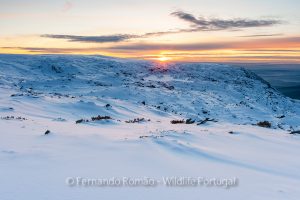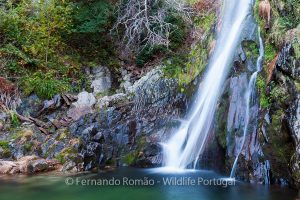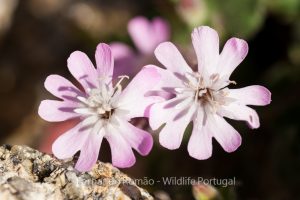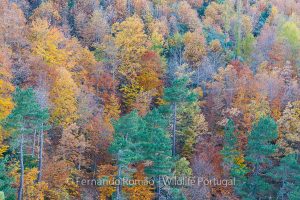With almost 2000m above sea level, Estrela Mountain is the highest mountain of continental Portugal. Imposing and spectacular rocky landscape, it is deeply marked with the scars left by the glaciers of erstwhile. Furthermore, it features mountain-specific habitats and numerous endemic species of plants and animals, some of which do not exist anywhere else in the world.
Estrela Mountain is the natural area of excellence for nature lovers.
This Mountain has important natural values. Because of its altitude, the geographic isolation allowed certain species of animals and plants to find refuge or to evolved here separately from other populations, thus creating distinct and specific species for this territory.
In the higher altitudes, you can find and watch with ease, the ex-libris of the Estrela reptiles, the Iberian Rock Lizard (Iberolacerta monticola), an endemism of this Mountain.
It is also possible to see some insects that are exclusive from here. The Monotropus lusitanica, the Iberodorcadion brannani the Zabrus estrellanus and the Ctenodecticus lusitanicus are the main ones. Other species found in Estrela Mountain its exclusive distribution area in Portugal. Such is the case of the dragonflies Moorland Hawker (Aeshna juncea) and Yellow-winged Darter (Sympetrum flaveolum) and the Black Satyr (Satyrus actaea) butterfly.
From the group of existing birds and that we can observe at Estrela Mountain Natural Park, some of them find in this mountain its preferred habitat at national level. From a list of about 100 species of residents birds, we can highlight the following:
Rock Thrush (Monticola saxatilis), Ortolan Bunting (Emberiza hortulana), Rock Bunting (Emberiza cia), Montagu’s Harrier (Circus pygargus), Peregrine Falcon (Falco peregrinus), Northern Wheatear (Oenanthe oenanthe), Tawny Pipit (Anthus campestris), Short-Toed Snake Eagle (Circaetus gallicus), Booted Eagle (Hieraeetus pennatus), Crag Martin (Ptyonoprogne rupestris), Dipper (Cinclus cinclus), Common Redstart (Phoenicuros phoenicuros), Chough (Pyrrhocorax pyrrhocorax).
In terms of flora, there is a wide variety of plants and flowers that lend their color to the paths and slopes of the mountain. Like the animals, some elements of the botany only survive in this mountainous territory. The highest ground of Estrela presents pseudo-alpine features and therefore the vegetation is mostly formed by small-sized plants, shrubs and creeping plants like the Juniper (Juniperus alpina) and grasses such as Festuca henriquesii and Cervum (Nardus stricta), plants adapted to the adverse weather of winter with a regular coverage of snow. The Campanulla herminii, a beautiful blue flower that is associated with altitude pastures (cervunais) and the Silene foetida subsp. foetida, bloom during the summer months. But since the middle of winter and early spring we can see several species of daffodils (some are Iberian endemisms) and the Fritillary (Fritilaria nervosa). In wetter areas, we can still find the tiny Sundew (Drosera rotundifolia) a carnivorous plant.
In general, our activities cover the different aspects of the natural heritage of Estrela Mountain. However, we can direct the tours for a more specific approach.
Through our selected itineraries, the PHOTO TOURS are ment to allow participants to meet and photograph the most relevant aspects of the natural heritage of Estrela Mountain, whether the rock formations and the remains of glaciations, birds, reptiles and amphibians, insects, flowers, mountain scenery, water and, even in winter, landscapes with snow and ice.
Accompanied by a guide and experienced nature photographer, we can still, in a practical way, develop some techniques and photographic concepts.




THE BEST OF EACH SEASON:
Winter (December to March) – winter landscapes with snow and ice, daffodils and fritillary flowers.
Spring (April to June) – spring landscapes, fauna and flora, water.
Summer (July to September) – fauna (reptiles, amphibians, insects) and the most important flowers.
Autumn (November) – autumnal landscapes, deciduous and mixed forests, mushrooms, water.
Meeting point: Manteigas
Duration: 4 to 6 hours
Type: on vehicle, but with several stops for short walks
RECOMMENDATIONS AND TIPS
For this program comfortable shoes are needed (preferably hiking boots), pants, windbreaker and other garment adapted to the season and weather forecasts. Bring water. About the photographic equipment, although indicative, the ideal will be a reflex digital camera (DSLR), wide angle lens, another lens with longer focal (eg 70-200mm), tripod. Participants may bring other equipment (eg, macro lens, flash, filters, etc.).
Even during the summer, the weather can deteriorate very sunddenly and become somewhat harsh: strong winds, low temperatures, fogs. Depending on the weather conditions for the day of the activity, there may be, or not, a change or cancellation of the program.
HALF DAY
Up to 4 participants: 140,00 €
FULL DAY
Up to 4 participants: 195,00 €
For larger groups or other conditions, please contact us.
The price quoted includes a guide, transport from Guarda or local centre (if applicable), insurance.
Place reservations are only guaranteed after payment of 50 per cent of the registration fee.
Discount offer equal to VAT for private customers.
VAT is added to the prices indicated for companies and other organisations.
Through the contacts available, indicating your name and cell phone contact/email.
The reservation is only guaranteed upon payment of 50% of the registration fee.
email: info@wildlifeportugal.pt
phone: +351 918 068 872

 English
English


